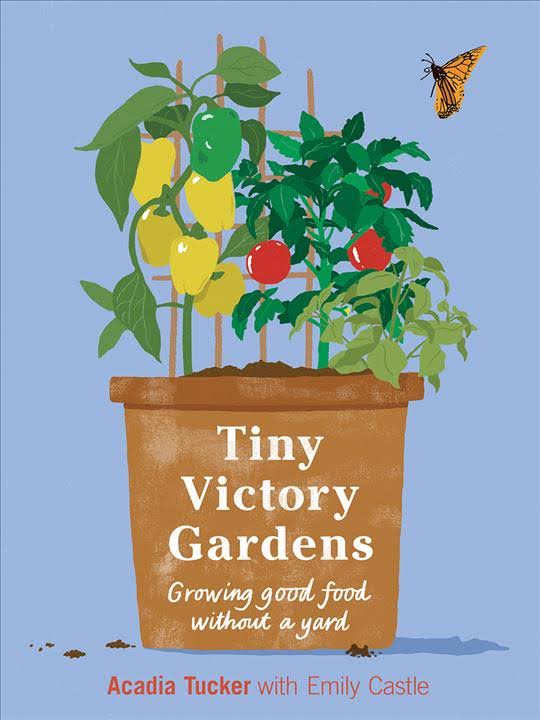Acadia Tucker is a market farmer turned container grower. After helping to manage 2 acres of regeneratively grown produce in Point Roberts, Washington, Tucker returned to her home state of Maine. A plastic-potted basil accompanied her for part of her cross-country journey and, with it, her love of growing plants in pots was ignited.

By Acadia Tucker, with illustrations by Emily Castle
Stone Pier Press, 2021
168 pages, paperback, $19.95
The reasons to grow plants in containers abound, Tucker writes in her latest book, “Tiny Victory Gardens: Growing Food Without a Yard.” Of course, there’s the obvious benefit to growing food in pots: as the book’s subtitle states, you don’t need access to land. Potted plants can be placed on a sunny sill, or on a patio or porch, or alongside an in-ground garden for supplemental space or portability. When filled with a compost-rich potting mix, container gardens are easy to tend and the harvests they yield are nutritious. Container gardening is also beneficial to pollinators. “Planting flowers and food in pots creates a safe zone in urban environments where food is already scarce, as well as in suburban areas rolling in manicured lawns, which are biological wastelands,” writes Tucker.
She continues to praise container gardening as a tool to adapt to a changing climate and build food system resilience: “The ultimate in food security — and I may be getting ahead of myself here — may be the ability to grow at least some of our food indoors.” Once back on the East Coast, Tucker began growing more and more food in containers — with much of it indoors. Late-season cherry tomatoes joined lettuce in deep containers to cheat the killing frost. Thyme, oregano and rosemary lined Tucker’s windowsills, pots of pickling cucumbers hung from curtain rods, and tropical plants, like lime and banana trees, basked in the heat of her living room.
Whatever your motivation for container gardening, “Tiny Victory Gardens” is a resource worth exploring. Tucker guides gardeners through the process of growing without a yard, starting with the soil. Her approach to soil is reverent — she credits living, healthy soil for her success as a grower — and offers a range of organic options for container mixes to suit budget, time and space constraints. Tucker also encourages soil-building practices, including mulching your containers with organic materials.
What I like most about this book is that it goes above and beyond what is typically thought of as “container gardening.” Sure, Tucker encourages growers to start small, with a single rosemary plant or a tomato in a pot placed in whatever sliver of sun is available to them. But, for readers interested in ramping up their sense of food security, she also outlines how to plant a mini-farm in containers, complete with: a pros and cons comparison of various containers (including all-important drainage vs. moisture retention considerations); year-round growing (including notes on how to overwinter tender perennials indoors in Maine as well as pollination for the indoor garden); and her favorite crops and varieties suited for small spaces (spoiler alert: she favors determinate tomatoes). In fact, a sizeable chunk of “Tiny Victory Gardens” is dedicated to a breakdown of the individual growing needs of specific herbs, fruits and vegetables.
Perhaps my favorite chapter is devoted to designing for small spaces. Tucker offers tips for planting for pollinators (for outdoor gardens) and for maximizing yields through vertical growing. She also keeps aesthetics in mind. After speaking with a florist whose bouquets she admires, Tucker adapts a well-known floral design adage — “aim to thrill, fill, and spill” — to create a “splendid-looking container farm.” Her companion planting recipe for “Super Salad Mix,” for example, combines eye-catching calendula to thrill, arugula and lettuce to fill, and nasturtium to spill.
Illustrations of garden design ideas and other how-to concepts as well as easy-to-reference charts are interspliced throughout the text. Readers can choose to read cover to cover or hone in areas of specific interest.
– Holli Cederholm
